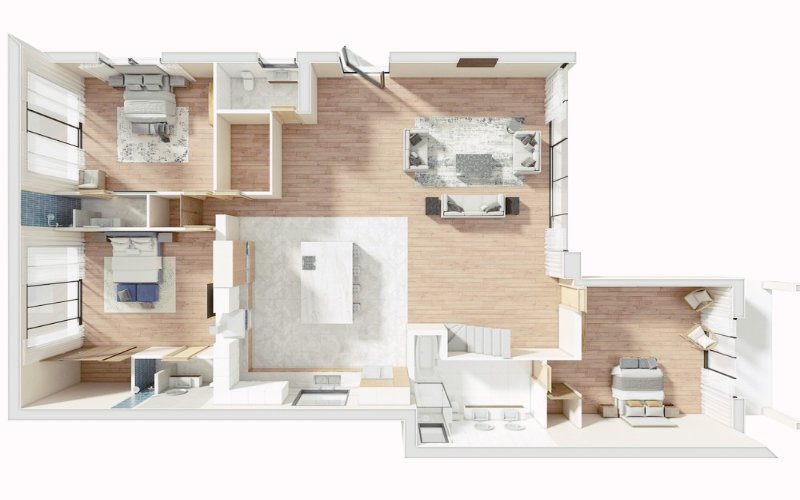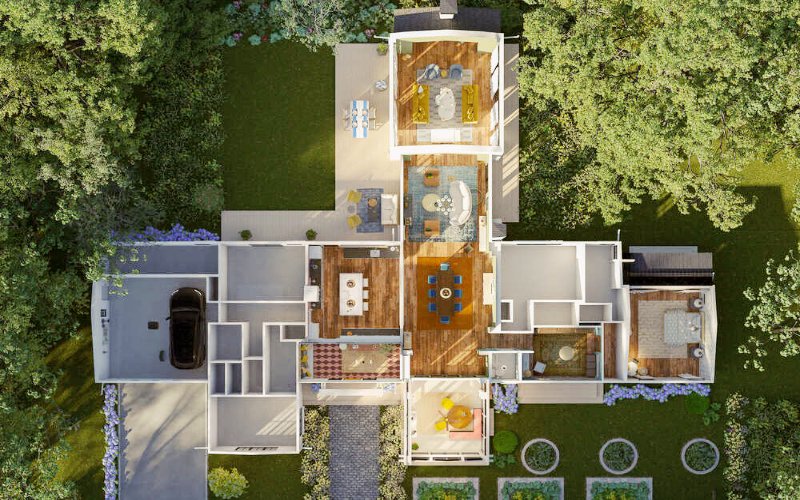Unveiling the Future: How 3D Floor Plans Transform Real Estate Sales
The Influence of 3D Floor Plans on Real Estate Sales
In the fast-paced world of real estate, where every square foot counts, making a property stand out is both an art and a science. Potential buyers aren’t just looking for houses; they’re searching for their future homes. The challenge for real estate professionals is to help them envision that dream. One remarkable service has emerged to meet this challenge head-on: services for creating 3D floor plans. These services offer immersive, interactive, and powerful tools for real estate agents and prospective buyers.
This comprehensive guide will explore the fascinating world of 3D floor plans and how they have transformed the real estate industry. We will uncover the origins of 3D floor plans, dissect their essential components, and delve into the myriad benefits they offer. From enhancing property listings to increasing sales and client satisfaction, 3D floor plans have become a game-changer. So, fasten your seatbelts as we journey through the captivating realm where blueprints become reality.
1. The Evolution of Floor Plans: From Blueprints to 3D Renders

Before we dive into the world of 3D floor plans, it’s essential to understand their roots in traditional floor plans and blueprints.
1.1. Traditional Floor Plans: The Foundation
Traditional floor plans have long been the standard in real estate marketing. They provide a two-dimensional property layout, showing the arrangement of rooms, walls, doors, and windows. These plans are typically black and white, making it somewhat challenging for potential buyers to visualize the property thoroughly.
Traditional floor plans served a valuable purpose in their time, helping buyers understand the basic layout of a property. However, they lacked the depth and detail to create a genuine emotional connection with a space.
1.2. The Birth of 3D Floor Plans
The digital revolution that swept through the real estate industry led to the development of 3D floor plans. These dynamic representations take the basic floor plan to a whole new level. They are designed to give viewers a realistic, immersive experience of a property’s layout and spatial arrangement.
The transition from 2D to 3D was a game-changer. Suddenly, potential buyers could see a home’s layout and virtually walk through it. This transformation significantly impacted the way properties are marketed and sold.
2. Anatomy of a 3D Floor Plan: Unveiling the Details

To truly appreciate the power of 3D floor plans, let’s dissect their anatomy. What makes them so effective in conveying the essence of a property?
2.1. Spatial Accuracy
One of the critical strengths of 3D floor plans is their ability to provide a precise representation of spatial dimensions. Unlike traditional floor plans, which can sometimes be challenging to interpret, 3D versions give viewers an accurate sense of room sizes, heights, and spatial layout.
Spatial accuracy is critical for buyers looking to understand how their furniture and belongings will fit into a space. It eliminates the guesswork and surprises when moving into a new home.
2.2. Realistic Visualization
3D floor plans excel in creating a sense of realism. Textures, colors, and lighting effects transform these plans into virtual replicas of the property. This level of detail allows potential buyers to envision themselves living in the space, making an emotional connection often elusive with traditional plans.
2.3. Interactive Exploration
Unlike static floor plans, 3D versions offer an interactive experience. Viewers can “walk” through the property, exploring every nook and cranny. This interactivity engages buyers deeper, holding their attention for more extended periods.
3. The Benefits of 3D Floor Plans: Making a Compelling Case

Now that we understand what 3D floor plans are made of, let’s explore the many advantages they bring.
3.1. Enhanced Property Listings
A property listing’s first impression can make or break a potential sale. 3D floor plans significantly enhance property listings with their visually stunning and immersive nature. They allow listings to stand out in a sea of competitors, catching the eye of potential buyers browsing online.
3.2. Time and Cost Savings
For real estate agents, time is money. 3D floor plans can save substantial time during property viewings. Buyers who have explored a 3D floor plan are more likely to be genuinely interested, reducing the number of wasted visits to properties that need to be the right fit.
Additionally, the cost of creating 3D floor plans has decreased over time, making them affordable for many property listings.
3.3. Increased Buyer Confidence
In real estate, transparency builds trust. 3D floor plans provide transparency that traditional floor plans can’t match. Buyers can see the property from various angles, giving them confidence in their decision-making process. They can assess if a property meets their needs and preferences without relying solely on the agent’s description.
3.4. Reduced Ambiguity
Traditional floor plans often leave room for interpretation, leading to misunderstandings or disappointments. 3D floor plans leave no room for ambiguity. They provide a clear and comprehensive understanding of the property’s layout, leaving no surprises for buyers.
3.5. Global Accessibility
In our interconnected world, real estate transactions often involve international buyers. 3D floor plans transcend language barriers and time zones. Prospective buyers worldwide can explore a property anytime, allowing for a more extensive reach and a quicker sale.
3.6. Competitive Advantage
Agents need to leverage cutting-edge technologies to stay competitive in the real estate market. Properties featuring 3D floor plans enjoy a competitive advantage, attracting more attention and interest. This technology signals buyers that the agent is forward-thinking and committed to providing an exceptional experience.
4. Beyond Residential Real Estate: The Versatility of 3D Floor Plans

While 3D floor plans are most commonly associated with residential real estate, their applications extend far beyond homes. Let’s explore how they are making an impact in various sectors.
4.1. Commercial Real Estate
In the world of commercial real estate, 3D floor plans are invaluable. They help prospective tenants or buyers visualize how to utilize office spaces, retail units, or warehouses. This technology assists in lease negotiations and property management decisions.
4.2. Hospitality and Tourism
The hospitality industry utilizes 3D floor plans to showcase hotel rooms, resorts, and vacation rentals. These immersive experiences allow travelers to explore accommodations before making reservations, enhancing their overall booking experience.
4.3. Event Planning
Event planners and venues use 3D floor plans to design and visualize event spaces. This helps arrange seating, stages, and decor efficiently, ensuring that every event succeeds.
4.4. Architecture and Design
Architects and interior designers rely on 3D floor plans to communicate their vision to clients effectively. These plans provide a tangible sense of how a space will look after renovations or new construction.
5. The Future of Real Estate: Embracing Innovation
The real estate industry is far from traditional floor plans and static images. Today, 3D floor plans are just one example of technology revolutionizing the sector. As we look to the future, several trends are emerging.
5.1. Virtual Reality Integration
Integrating 3D floor plans with virtual reality (VR) is on the horizon. This will allow potential buyers to don VR headsets and immerse themselves in properties as if they were physically present. It’s the ultimate way to experience a property without leaving the comfort of one’s home.
5.2. Augmented Reality Property Tours
Augmented reality (AR) tours are becoming more prevalent. Buyers can view 3D floor plans superimposed onto the actual property using a smartphone or tablet. This technology provides an engaging and informative experience during physical property visits.
5.3. Artificial Intelligence for Personalization
Artificial intelligence (AI) will be more significant in tailoring property recommendations to individual preferences. AI algorithms will analyze buyers’ interactions with 3D floor plans to suggest properties that align with their preferences and lifestyles.
6. Conclusion: The 3D Revolution
In conclusion, 3D floor plans have redefined how properties are marketed and experienced. Their ability to provide spatial accuracy, enhance property listings, save time and costs, and increase buyer confidence has made them indispensable in the real estate industry.
We can expect even more innovative ways to use 3D floor plans as technology evolves. Virtual reality, augmented reality, and artificial intelligence are poised to take this technology to new heights, offering buyers experiences that were once unimaginable.
For real estate professionals and property buyers alike, embracing the 3D revolution is not just about staying competitive but creating a more transparent, efficient, and enjoyable real estate experience for all parties involved. With 3D floor plans, the future of real estate is undoubtedly looking brighter than ever. So, whether you’re an agent looking to boost your listings or a buyer searching for your dream home, prepare to be amazed by the transformative power of 3D floor plans. Welcome to the future of real estate!
Also visit Digital Global Times for more quality informative content.

